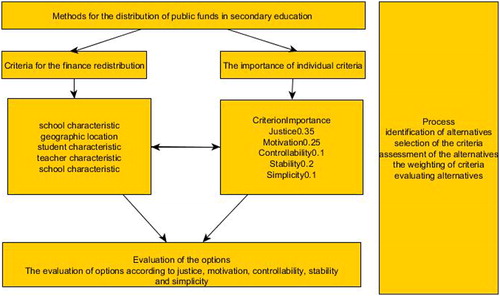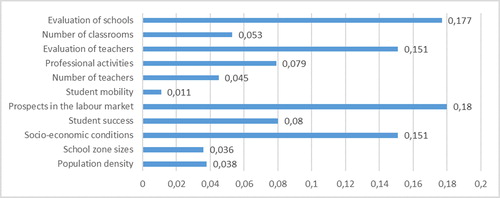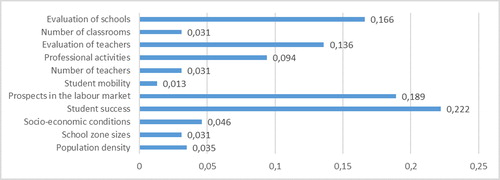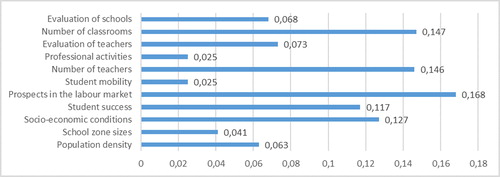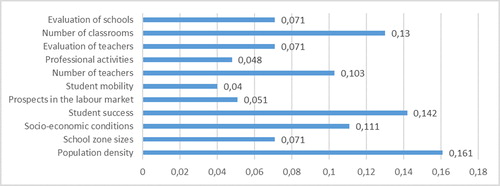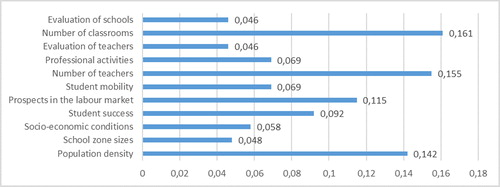Abstract
The aim of the paper is to analyse the current financing system for schools in the Czech Republic and the subsequent formulation of criteria for improving the redistribution of funds from public sources. First, the method of retrospective analysis of expenditures on education financing at European level and the developed countries of the OECD. Second, the multiple criteria model for the distribution of funds is established using Expert Choice. Finally, a method of guided interviews will be exploited in order to detect attitudes, priorities of representatives from the education department and the economic department in the Czech Republic. In the analysis of secondary school finance decision-making, individual solution options and key criteria were specified. The criteria include justice, motivation, stability, controllability and simplicity. Based on the multi-criteria evaluation output, it is possible to recommend the inclusion of three elements in the current financing system of secondary education in the Czech Republic. These are the tracking of graduates in the labour market, assessment of schools and teachers.
1. Introduction
The European Commission has appealed to Member States for many years to protect and promote long-term investment in education. Efficient and equitable distribution of resources also appears at the forefront of the political agenda. (European Commission, Citation2014) At the present, public finance is the main resource in all European countries. In the Czech Republic, they are represented in 90% of the total spending. The very process of redistribution of funds usually involves more than one administrative level. The main ones include the central (national), the regional (local) as well as at school level. Generally, expenses for personnel, i.e., educators, are the largest item in the budget of state schools. In more than one-third of European countries, the central level allocates funds for teachers directly to schools. Whether it's Ireland, Spain, Croatia, Cyprus, the Netherlands, Portugal or Slovenia. In some countries, the highest level of management is directly covered by teachers’ salaries. These are Belgium, Germany, Italy, Hungary, Malta and Liechtenstein. (European Commission, Citation2014) Capital funds are financed on the basis of budgets and the approving process by the responsible authority.
The financing method is one thing, but are the specific criteria according to which money redistributes, effective and appropriate? Although the general public agrees that the current system of funding per pupil is weak, the views on the solutions differ and are limited.
The aim of the paper is to analyse the current system of financing these schools in the Czech Republic and the subsequent formulation of criteria for improving the redistribution of funds from public sources, using multi-criteria decision-making of Expert Choice.
2. Literature review
Within analysing the financing sources the studies have generally focused on approaches and maybe solutions in different countries. Barr (Citation2004), Schiller and Liefner (Citation2007). Schiller and Liefner (Citation2007) analysed the Thai higher education system in the context of higher education funding reform aimed to cut public spending and to stimulate university-industry co-operation as a means to obtain additional university income. The results showed improvement of co-operation, however negligible financial benefits for universities.
Liefner (Citation2003) specified forms of resource allocation in university systems and their effects on performance in higher education institutions and analysed how various forms of funding and resource allocation affect universities at the macro-level and Individual behaviour at the micro-level. The author suggested that performance-based funding tends to bring about positive changes but is also a factor in unintended side effects. Barr (Citation2005) analysed and discussed three different financing arrangements. These options each take-off from a different idea about who takes the lead in shaping the higher education landscape. The leading participant is actually (1) the student, (2) the higher education institution, or (3) the government. Barr (Citation2005) specifies aspects of the education reform in the Great Britain.
Jongbloed (Citation2008) in his study ‘Funding higher education: a view from Europe’, is trying to get a more comprehensive view of European Union countries, as well as for example Heller and Rogers (2010), Weiler (Citation2000), Keeling (Citation2006) or previously Maassen (Citation2000).
From the methodological point of view of using decision-making methods Coleby, Aspinall, and Miller (Citation2007) used the multi-criteria model techniques for the ranking of one or more expert decisions with respect to both qualitative and quantitative factors. Pazek et al. (2010) used the goal of DEX-i decision model to provide answers which business alternative is the most suitable for the given model organic mountain farm. The DEX-i model was constructed by the following steps (Bohanec & Zupan, Citation2004): the decomposition of the decision problem; definition of value scale for qualitative attribute; utility functions for each aggregate attribute. Ho et al. discuss matching as nonparametric pre-processing for reducing model dependence in parametric causal inference and present a coherent unified perspective for applied research.
However, all of the above studies, whether they are focused on approaches to theories or they are more application approaches show that there is no universally valid, correct procedure for distributing finance. The criteria is to be discussed in the context of other conditions such as the economic situation of the country, education or geographic distribution.
3. Methods
First, retrospective analysis of expenditures on education financing at European level and the developed countries of the OECD. For source data there are selected international studies, ministries websites of various countries and international statistical database.
Second, the multiple criteria model for the distribution of finance is established. Multiple criteria decision-making (MCDM) refers to making-decisions in the presence of multiple, usually conflicting criteria (Xu & Yang, Citation2001). Different solution options are the decision-making criteria and their importance are defined. Namely: it was proceeded according to the following steps:
identification of alternatives,
selection of the criteria,
impact assessment of the alternatives in relation to the individual criteria,
the weighting of criteria,
evaluating alternatives.
For greater deployment objectivity of this method, five experts from the areas of public finance (2) and education (3) were involved to select and determine the importance of the criteria. Those were sent a table with the proposed criteria and their task was to assign importance to them and to determine the impact of the various options in relation to the criteria. The evaluation of criteria and defining the importance covered the period of 1.10. 2015–15.12.2015. The outcome of this work includes relevant elements that needs to be incorporated into the current system of secondary school financing. Overview of hierarchy processing is described in the .
Then the guided interviews method will be exploited in order to detect attitudes, priorities of the representatives from the education department and the economic department in the Czech Republic. Feedback on the specified model took place in the context of the themes of finance redistribution to schools, the current education reform and applicability of the proposed changes. The first feedback was obtained during 2016, further comments were made in October 2017.
4. Results
4.1. The finance redistribution methods in European countries
Standard funding based on tracking a single category, for example the re-distribution of finance according to the number of students, is considered by the European Commission as the most transparent way of funding. Although they admit that it is necessary to take into account the socio-economic environment and equitably allocate resources to where they are needed. Power financing method exists in two versions. Either it motivates for good results, or punishes poor results. It also entails the adverse consequences. Good schools, in which people are highly interested in, have space for improvement. Unpopular schools have it much harder and there is no space for improvement. The European Commission in this regard recommends to watch absolute indicators and criteria for school funding as well as to take into account the progress of the school and monitor development in time series. Analysis of the European Commission in this regard has identified three basic methods of financing: (European Commission, Citation2014)
Funding formula – reallocation of resources on the basis of universally agreed formula or rules
Budgetary approval – submission of the budget drawn up by schools or another authority for the approval by the responsible institution,
Discretionary determination of resources – the responsible funding authority has complete discretion in the allocation of resources. It works on a case by case basis following the estimate of financing needs.
In virtually all European countries, resources for teachers are centrally determined using the formula. In northern European countries, these funds are partly determined by means of a fixed subsidy, or a portion thereof. Generally, the key factors include class size, teaching duration including time of teaching. The central levels are involved in a similar manner in individual countries also in determining funding for school operating expenses. The exceptions are Germany, Austria, Croatia and Iceland, where it doesn’t deal with the central level and has delegated this authority. The Nordic countries use lump sums for the capital expenses generated by the formula, the western countries use generally grants. It’s evident that methods vary across Europe, even though sometimes it's only in the details. It is important to also look at funding in terms of which criteria are used to redistribute public finance.
In England, the autonomy of the local authorities is only partial, but everyone can choose from a centrally drawn up list of 12 factors regarding school development. This is a basic entitlement for all schools, deprivation in connection with food for pupils, prior attainment, supervising pupils, teaching a second language, pupil mobility, accessibility, lump sum, fragmentation of localities, evaluation of schools, private finance initiative contracts and London fringe) (Education Funding Agency, Citation2015).
For example in Wales you can define your own formula for block grants awards in relation to expenditure on staff. However, 70% of the funds must be distributed with respect to the number of pupils and the rest is carried out based on the authorised factors: the size and condition of buildings, school meals and so on (European Commission, Citation2014).
It is still true that developed countries try to settle the school differences between regions and therefore ensure the equality of opportunities. For example, in the UK and Slovak small schools or local authorities receive extra resources. Consideration is also being given to higher costs for different age groups see Poland, Czech Republic, Slovakia, or specific courses funded separately (arts, sports, etc.).
Approximately two-thirds of European countries respond to the geographical location of a school and the level of socio-economic environment. Belgium, France, Finland, the United Kingdom and the Baltics also take population density into account in the redistribution of funds among individual schools, or rural and urban parts (European Commission, Citation2014).
Most countries take into account funding with regard to the number of population.
4.2. Criteria for the finance redistribution
Based on the analysis of foreign approaches to the finance redistribution (Education Law Center, A National Report, Citation2010; European Commission/EACEA, Citation2014; OECD, Citation2015) four criteria has been selected:
geographic location
student characteristic
teacher characteristic
school characteristic
As it has already been mentioned, for greater objectivity of the deployment of this method five experts from the field of public finance administration were involved in selecting and determining the importance of the criteria, whose task was to assign importance to them and to determine the impact of the various options in relation to the criteria.
4.2.1. Geographic location
The differences across regions can be seen in teacher salaries, school district size, population density or generally in terms and conditions of education. (Education Law Centre, National Report, 2010) In addition, there are different economic and social conditions in each region. Therefore, it is necessary to also take into account the socio-economic environment, as is the case for example in Sweden and Finland, where the level-zone schools are. If this area is included in the reallocation of resources, it can be solved through the determined coefficients or categories of schools, as it is for example in the Nordic countries. With an equitable distribution of finance the system should take into account the so-called lack of students – student poverty in individual schools or regions. According to the study, the education systems are divided into progressive – where these schools or areas receive more resources; regressive – where the situation is reversed and equal conditions for all – i.e., flat systems. (Education Law Centre, National Report, 2010) The advantage clearly lies in the fact that the funds are redistributed according to the needs of regions and rural schools are not advantaged. The complications occur as soon as the category or the coefficient would be created so that it is fair. Specific elements to be included in the model are:
population density – a factor in relation to the population density per region or square kilometre,
size of school zones – based on its closest surroundings or student commuting
socio-economic conditions – a comprehensive solution in terms of living standards, unemployment, and other aspects. School zoning.
4.2.2. Student characteristics
The authors consider it essential to take into account the results of individual students or schools and evaluate (i.e., provide finance) schools according to measurable characteristics from their outputs. It should take into account the gaps in educational attainment or knowledge of the key subjects. (Education Law Centre, National Report, 2010)
One of the conference outputs relating to the changes in the regional schools financing is to reflect the success and employability of school graduates (MSMT, Citation2015). Confederation of industry and traffic of the Czech Republic also considers the need to supplement the current system by a factor of employability of the graduates in the labour market. The mobility of students is also a factor that plays an important role, some countries attach more importance to it than others.
The advantage of the characteristics of the pupils is undoubtedly the fact that the outputs can be measured quite well. The downside is the issue of the added value created by the school itself or the presumptions of individual pupils. Specific features are summarised as follows:
success of students – study results, continuous assessment of students, the results of the admission procedure,
employability – finding a job within a certain time both in the field of study and outside of it, a predefined coefficient,
student mobility – zoning of schools based on the frequency of mobility and student results in abroad.
4.2.3. Teacher characteristic
Within teachers it is possible to monitor their expertise and years of experience, and then financially support secondary schools so that they are sufficiently motivated. It also relates to the lifelong learning of teachers. That’s the only way to ensure long-term quality teaching.
In connection with that the Czech School Inspectorate carries out an interim evaluation of schools and teachers, evaluating the quality of teaching. Based on the evaluation of the inspection it is possible to financially favour successful teachers or schools.
The elements can be summarised as follows:
number of teachers – with embedded field coefficient,
professional activities and lifelong learning of teachers – long-term activity of teachers, efforts to develop and improve. Practical projects and research,
teacher evaluation – a comprehensive solution, evaluation from several aspects. Evaluation of school inspections, students and parents. Co-operation with companies and teaching quality.
4.2.4. School characteristics
The Confederation of Industry and Traffic in the Czech Republic proposes solutions in the form of determining the performance unit of class. In addition, the county would have the opportunity to realise an ‘order’ for the particular school or the opportunity to establish a factor evaluating school quality according to the objective criteria. One of the main characteristics of school is therefore the amount of classes. Under current legislation, a class must have at least 17 pupils. If a starting unit of output was the number of classes it could be expected to see disadvantaged schools in small towns or rural areas. Another opinion between the representatives of companies is to monitor the quality of teaching or the coefficients within the intensity of the given field and the needs in relation to the labour market. I regard it as crucial. Secondary education should reflect the needs of the labour market. Moreover, it is impossible to compare secondary vocational schools with grammar schools. Ministry of Education considers necessary to take into account sectoral grant per student, who in addition to the industry also takes into account for example group lessons.
The characteristics of a school include its facilities. It undoubtedly has an impact on the teaching process and subsequent investment costs of the founders. In this regard, again I can imagine a coefficient in the evaluation of a school within a school inspection. The founders of secondary schools (i.e., regions) could then invest the money where it is particularly needed, instead of processing the applications and discussing them with lobbies.
Elements to improve the current system can be expressed as follows:
number of classes – funding based on the number of pupils in classrooms,
school evaluation – a comprehensive evaluation of a school by school inspection, founder, students and parents.
4.3. Specifications and evaluation of the impact of the various options in relation to individual criteria
The previous chapter prompts several elements or sub-characteristics that should be incorporated into the current model of redistribution of funds to secondary schools. There are defined possible solutions, then the criteria and their importance and possible outputs are designed using the Expert Choice software. Criteria included in the model are: justice, motivation, accountability, stability, simplicity.
A Fair system is a system in which large schools are not favoured and small schools penalised. Within a similar region, comparable schools should receive the same amount of resources. Mutually competing schools have the same conditions in terms of public resources.
The financing system should motivate a school, so as it has the interest to develop and work to improve. The possibility of inspection is also essential for the authorities dividing the finance.
Furthermore, finance must represent stability for school. The school should also be assured that they receive the funding timely and can retain the position in the education market in the long-term. Funds must be received based on factors that the school can affect. The actual solution is not created for one term, but it must be durable over time. Finally, the system of financing costs more money from the state budget. Whether it's regarding ensuring the capacity of people, software or hardware. It is important to also take into account the administrative requirements. All these aspects are covered in this criterion – low simplicity. The simplicity also means the complexity of the transition from the current system.
4.3.1. The importance of criteria
The below shows the importance of each criterion. The analysis also takes into account the variation of an equitable sharing of criteria, i.e., all with the importance of 0.2.
Table 1. The importance of individual criteria.
Based on the discussion with experts justice was identified as the most important criterion, followed by motivation and stability.
4.3.2. Evaluation of the options
Evaluation of the options according to the individual criteria was held with the support of the Expert Choice program. provides a detailed insight into the comparison according to the criteria of justice. The outcome of the comparison is the value on the right, where there is a summarisation of the score. The sum of the points is equal to one. High-point score was assigned to rating schools and socio-economic conditions. It is known that in the Czech Republic the circumstances are different in different regions as well as each region is heterogeneous, so it is fair to take into account the environment and conditions of individual schools. Evaluating teachers is also designated as fair. The teacher is the person, who creates a quality environment at school. It is crucial to choose objective and measurable criteria.
Furthermore, it was concluded that less unfair is to monitor the success of students, in that case it is difficult to demonstrate the added value of the school, personality traits and attitudes. Even professional school activity does not bring equal conditions for all, each of them has different capabilities and capacities. The number of classes and the number of teachers are also not an objective criterion. These criteria are as fair as the current normative model of funding per student. The unfair criteria are mainly those that cannot be influenced from the perspective of school, i.e., population density, which is more or less unchanged in time, and size of school zones.
The following comparison gives an insight into motivation. The success of students and prospects on the market is in accordance with this criterion. A high-point score were gained by the criteria which are motivating for improving the skills of students, teachers and schools. At the opposite end of the evaluation there are the options that cannot be affected by the school and therefore cannot be regarded as an incentive, for example the mobility of students, school zone sizes, or population density ().
shows point score according to controllability. The market penetration is simple and therefore well controllable. In this respect, it is good to take into account the work in the field or outside of it. An easily controlled solution includes funding per a classroom or number of teachers.
In terms of controlling the redistribution of funds, the factor of mobility of students and professional school activities are considered to be important. Low-point score was given to the option of fund redistribution based on the size of school zones. The problem arises with the first determination of the size of the territory and then subsequent update and feedback.
Appropriate factors in relation to the stability criterion include population density, which in time changes very little. Furthermore, the success of students, which in the case of school efforts it could be a stable criterion, and the number of classrooms and teachers ().
Relatively high ratings were obtained by the ‘number of schools’ and ‘socio-economic conditions’ options, due to the fact that in the long run they may not change, they are relatively suitable in the Czech Republic environment. The size of school zones does not have to change in time, bud if we include travelling of students into this criterion, such a system will be quite unpredictable. The problem occurs even when a new school is formed. It is necessary to recalculate the size of schools in the region. On the other hand, weak ratings were received by the employability of graduates, professional activities and student mobility.
The higher-point score is obtained by the very ones who simply ensure, calculate and define. They are not time, cost or capacity demanding. Formula funding based on the number complies with these aspects. If the system is to be more sophisticated and complex it is necessary to have administrative capacity, and the solution is expensive and time consuming. It occurs when every school, teacher or student is to be evaluated separately see .
Based on the comparison of all alternatives according to the all criteria (justice, motivation, controllability, stability, simplicity), the total output was consistent. Criteria importance are determined by the team described above and the importance of individual factors is described in .
Table 2. Total output of criteria importance.
The highest-point score was achieved by employability, followed by the evaluation of schools and the evaluation of teachers. The question is how such an evaluation should look.
On the contrary, what the solution should not contain is the mobility of students and professional school activities. The same is true when taking into account the size of the school zones. These are the criteria which would favour certain types of schools.
5. Discussion
The number of secondary school students in the Czech Republic decreases year-on-year.
Over the past six years, the number of students per school decreased by more than 60 on average. One of the tools for influencing education is of course finance. Ninety percent of school expenditure in our country is covered by public budgets, as is the average in OECD countries. Average expenditure per pupil in the Czech Republic is below the average for this group of developed countries. On the other hand, more than 70% of the population passes through secondary education, which is the highest number of all OECD countries. There is no country in Europe that does not take the number of pupils in the area of finance redistribution into account. The most frequent way is to set a flat rate for a pupil or purpose-spent subsidies. The extra question is who should decide on the redistribution of money. On the European continent, the situation is different. Generally, three levels (central, regional and local) can be allocated. In the Czech Republic, it’s evident that there are relatively large differences in the redistribution of money across the regions and regional normative are same in many cases in different fields.
The perfect model without errors definitely does not exist, but how should the finances be redistributed?
The results of the model and the main criteria were discussed with the head of the economic department in the selected region, accountancy department of education and the head of the department of education in one of the regions in the Czech Republic.
The head of the economic department considers it appropriate to include the criterion of evaluating teachers and employability of graduates in the labour market into school financing. The accountancy department of education of Hradec Králové region considers it necessary to address the education reform. As a unit of output in the financing she can imagine sectoral normative relating to the average number of pupils per classroom. She considers it essential to set conditions for school funding so that they lead to motivation and satisfaction of employees, to motivate students and the overall competitiveness of the Czech educational system. This criterion is therefore deemed as essential. She also stated that the employability of the graduates in the labour market should be monitored and this should be one of the criteria. Evaluation of schools is also important according to her. While the regional authority checks law enforcement at schools every 3 years, school inspections carries out school evaluation at a fairly regular basis. She agrees with the idea to let evaluate a school by students and their parents, and therefore to add another insight into the assessment and not to base only on subjective opinions of individuals or a single institution.
The head of the department of education believes that financing of secondary schools should take the network and structure of schools in the regions into account more. Conversely they see as complicated to watch the employability of the graduates. They see monitoring the amount of pupils per classroom as the performance unit of the normative financing as realistic.
Their overall view of the outcome of the multi-criteria analysis is that the monitoring graduates employment in the labour market should be incorporated into the current system and support prospective schools accordingly, based on the evaluation of schools and teachers to redistribute finances. If schools and teachers can influence the level of subsidies with their activities, only such conditions are motivational and the aim is the development and competitiveness of Czech education.
6. Conclusion
The analysis of the criteria for decision-making on the funding of secondary schools defines the individual options of solutions and key criteria. Justice, motivation, stability, controllability and simplicity, those aspects are necessary for the system. Based on the output we can recommend the inclusion of the three elements to the current system. These include tracking of the graduates in the labour market, school evaluation and teacher evaluation. If schools and teachers can influence the amount of subsidies by their activities, only such conditions are motivational and the goal is the development and competitiveness of Czech education.
The above model has certain limitations. It is the nature of the multi-criteria decision-making method, which is subjective and is influenced by the selected team, which determines the importance of the criteria. To increase the quality of the model it would be suitable to invite more experts to the evaluating team. The actual results should highlight the importance and possibilities in the field and are used for further discussions, especially at political level.
Declarations
Ethics Approval and Consent to Participate
Not applicable in this section.
Competing interests
The authors declare that they have no competing interests to declare.
Availability of data and materials
All the data and materials in this manuscript will be shared.
Acknowledgement
This research was supported by the internal project at Faculty of Informatics and management (SPEV 2018 and 2019). In addition, the authors thank Michal Bark for her help with the research.
References
- Barr, N. (2004). Financing higher education. Oxford Review of Economic Policy, 20(2), 264. doi: 10.1093/oxrep/grh015
- Barr, N. (2005). Financing higher education: Answers from the UK (1 ed.). London: Routledge
- Bohanec, M., & Zupan, B. (2004). A function-decomposition method for development of hierarchical multi-attribute decision models. Decision Support Systems, 36(3), 215–233. doi: 10.1016/S0167-9236(02)00148-3.
- Coleby, M. A., Aspinall, P. A., & Miller, D. R. (2007). Assessment of public > acceptability regarding wind turbine construction as perceived by environmental professionals. Journal of Environmental Assessment Policy and Management (Management). World Scientific Publishing Co. Pte. Ltd., 9(1), 45–65. doi: 10.1142/S1464333207002706
- Education Funding Agency. (2015). School revenue funding 2015 to 2016. England, UK: Operational Guide.
- Education Law Center. (2010). Is school funding fair? A National Report. Newark, NJ: Education Law Center.
- European Commission/EACEA/EURYDICE. (2014). Financing schools in Europe: Mechanisms, methods and criteria in public funding (Eurydice Report). Luxembourg: Publications Office of the European Union.
- Heller, D. E., & Rogers, K. R. (2006). Shifting the burden: Public and private financing of higher education in the united states and implications for Europe. Tertiary Education and Management, 12(2), 91–117. doi: 10.1080/13583883.2006.9967162
- Ho, W., Higson, H. E., & Dey, K. P. (2007). “An integrated multiple criteria decision making approach for resource allocation in higher education,”. International Journal of Innovation and Learning, 4(5), 471–486. pages doi: 10.1504/IJIL.2007.012958
- Jongbloed, B. (2008). Funding higher education: A view from Europe. Paper prepared for the seminar funding higher education: A comparative overview organised by the National Trade Confederation of Goods, Services and Tourism (CNC). The Netherlands: University of Twente.
- Keeling, R. (2006). The Bologna process and the Lisbon research agenda: The European Commission’s expanding role in higher education discourse. European Journal of Education, 41(2), 203–223. doi: 10.1111/j.1465-3435.2006.00256.x
- Liefner, I. (2003). Funding, resource allocation, and performance in higher education systems. Higher Education, 46(4), 469–489. doi 10.1023/A:1027381906977
- Maassen, P. (2000). Models of financing higher education in Europe. A Background Paper Commissioned by the Nordic Council of Ministers for the Conference on “Financing Higher Education”, Held in Reykjavík, 3-4 April 2000. University of Twente.
- MSMT. (2015). School for the future - a future for the school. Retrieved from https://www.youtube.com/watch?v=pJFrGNzuSoA&list=PLD_48WTXRpqNFUtPbGI4_pdRGHk6R8TAt&index=15
- OECD. (2015 December 02). Education at a glance 2015: OECD indicators. OECD Publishing. Retrived from http://dx.doi.org/10.1787/eag-2015-en
- Pažek, K., Rozman, Č., Bavec, F., Borec, A., & Bavec, M. (2010). “A multi-criteria decision analysis framework tool for the selection of farm business models on organic mountain farms”. Journal of Sustainable. Agriculture, 34(7).
- Schiller, D., & Liefner, I. (2007). Higher education funding reform and university–industry links in developing countries: The case of Thailand. Higher Education, 54(4), 543–556. doi: 10.1007/s10734-006-9011-y
- Weiler, H. N. (2000). States, markets and university funding: New paradigms for the reform of higher education in Europe. Compare: A Journal of Comparative and International Education, 30(3), 333–339. doi: 10.1080/713657469
- Xu, L., & Yang, J. B. (2001). Introduction to multi-criteria decision making and the evidential reasoning approach (Working Paper No. 0106). Manchester School of Management University of Manchester Institute of Science and Technology.

